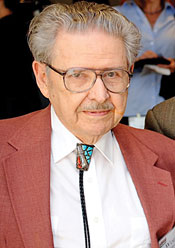Lewis Worth Seagondollar
DOI: 10.1063/PT.3.2319
Lewis Worth Seagondollar, longtime secretary of the Southeast Section of the American Physical Society, influential president of the physics student honor society Sigma Pi Sigma, and emeritus professor of physics at North Carolina State University, died at his home in Raleigh on 20 September 2013.

Lewis Worth Seagondollar
BRAND FORTNER, NCSU PHYSICS DEPARTMENT

Born in Emporia, Kansas, on 30 September 1920, Worth graduated from what is now Emporia State University in 1941. He enrolled soon after in graduate school at the University of Wisconsin–Madison and began working with Raymond Herb on accelerator construction. In 1944 he went to Los Alamos to join the Manhattan Project, and he found himself in the spring of 1944 as part of a three-person team that measured the critical mass of plutonium-239.
As the junior member of the team, Worth worked the overnight shift. In an episode that encapsulates his unfailing optimism that every problem has a solution, he succeeded in hammering out a small dent in one of the plutonium hemispheres after it was dropped on a table. Stationed nine miles away in Alamogordo, New Mexico, Worth witnessed the first nuclear test, and his experiences formed the basis of a memorable presentation he gave hundreds of times to civic and student groups over the following 50 years.
Worth returned to Wisconsin in 1948 and, as the first student of Heinz Barschall, completed a dissertation in 1947 on fast-neutron cross sections on aluminum. He then participated in the installation of the research Van de Graaff accelerator at the University of Kansas. Worth worked as a professor of physics at Kansas before moving in 1965 to NC State, where he served as head of the physics department for 10 years. While at NC State, he cofounded the Triangle Universities Nuclear Laboratory and measured nuclear cross sections with secondary neutron beams and with cryogenic polarized targets. After retiring in 1991, he remained as professor emeritus; younger researchers gratefully remember his willingness to help and advise them.
Worth offered years of dedicated service to ΣΠΣ and to the Society of Physics Students (SPS). It was during Worth’s tenure as ΣΠΣ president that the honor society merged with the American Institute of Physics (AIP) to form SPS. According to ΣΠΣ’s official history, as the presiding officer, Worth “allowed everyone to have his say and yet kept to the agenda (while he ‘chain-smoked 75 cigars!’).” Needing a two-thirds majority to pass, the articles of agreement between AIP and ΣΠΣ were approved with one vote to spare, 181 out of 270 (see Donald Cunningham and coauthors, Physics Today, September 1968, page 59
Worth’s 23 years as secretary of the Southeast Section of the American Physical Society was the longest tenure of anyone in that position. He steered the section through a period of rapid growth in the physics departments and research facilities in the Southeast and associated growth in participation at section meetings. He received two of the section’s highest awards, one for excellence in teaching physics in the Southeast and the other for service to the section.
In retirement, and well into his eighties, Worth remained an active speaker and was invited to give many talks; he felt particularly honored to speak at the ΣΠΣ quadrennial meeting in Albuquerque in 2004. For many years he also set his scientific and managerial skills to planning and executing yard-sale shopping trips. He was known for his early use of GPS to optimize shopping routes. Worth was one of only a few people to ever buy a used, working Mercedes-Benz at a yard sale. He also found many pieces of semi-antique scientific equipment in similar unlikely venues.
More about the Authors
Chris Gould. North Carolina State University, Raleigh.
David Haase. North Carolina State University, Raleigh.
